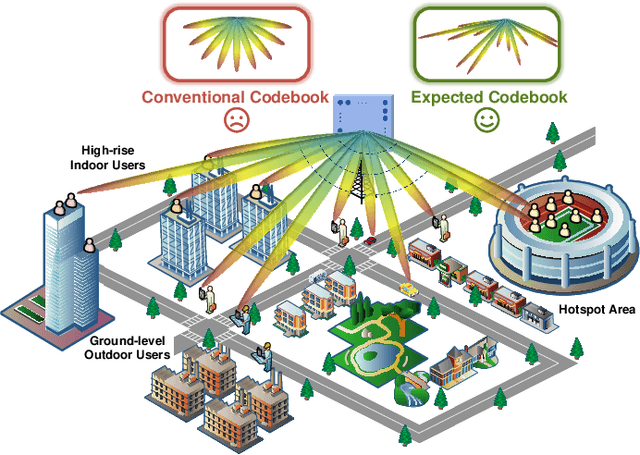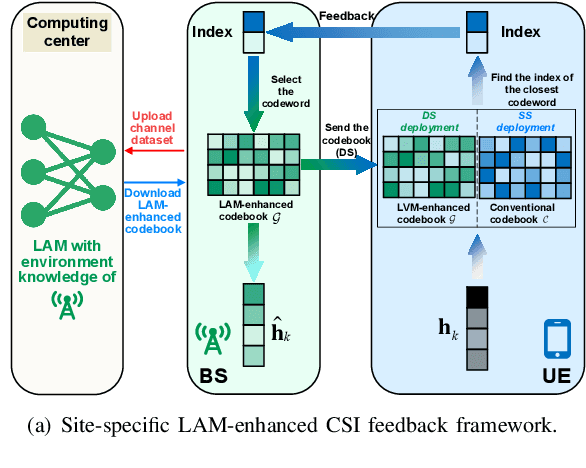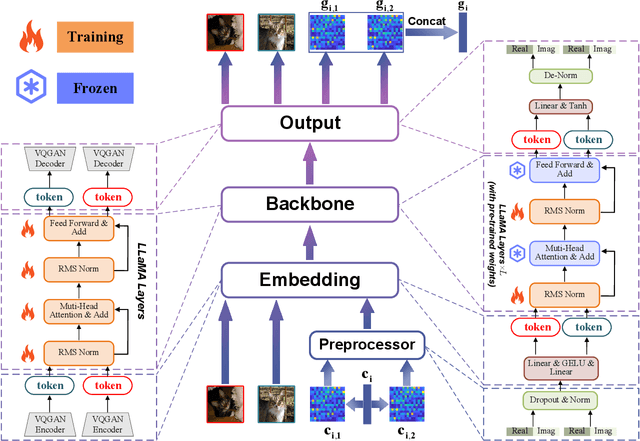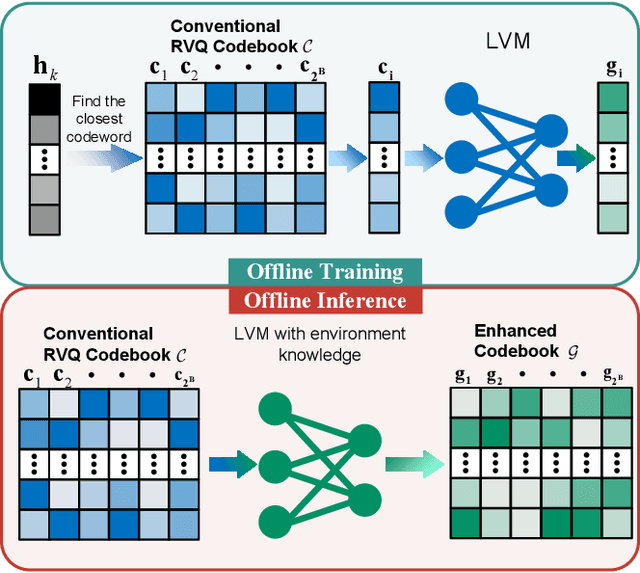Jiangzhou Wang
Fellow, IEEE
Large-Model AI for Near Field Beam Prediction: A CNN-GPT2 Framework for 6G XL-MIMO
Oct 26, 2025Abstract:The emergence of extremely large-scale antenna arrays (ELAA) in millimeter-wave (mmWave) communications, particularly in high-mobility scenarios, highlights the importance of near-field beam prediction. Unlike the conventional far-field assumption, near-field beam prediction requires codebooks that jointly sample the angular and distance domains, which leads to a dramatic increase in pilot overhead. Moreover, unlike the far- field case where the optimal beam evolution is temporally smooth, the optimal near-field beam index exhibits abrupt and nonlinear dynamics due to its joint dependence on user angle and distance, posing significant challenges for temporal modeling. To address these challenges, we propose a novel Convolutional Neural Network-Generative Pre-trained Transformer 2 (CNN-GPT2) based near-field beam prediction framework. Specifically, an uplink pilot transmission strategy is designed to enable efficient channel probing through widebeam analog precoding and frequency-varying digital precoding. The received pilot signals are preprocessed and passed through a CNN-based feature extractor, followed by a GPT-2 model that captures temporal dependencies across multiple frames and directly predicts the near-field beam index in an end-to-end manner.
Towards Reliable Emergency Wireless Communications over SAGINs: A Composite Fading and QoS-Centric Perspective
Oct 08, 2025Abstract:In emergency wireless communications (EWC) scenarios, ensuring reliable, flexible, and high-rate transmission while simultaneously maintaining seamless coverage and rapid response capabilities presents a critical technical challenge. To this end, satellite-aerial-ground integrated network (SAGIN) has emerged as a promising solution due to its comprehensive three-dimensional coverage and capability to meet stringent, multi-faceted quality-of-service (QoS) requirements. Nevertheless, most existing studies either neglected the inherent characteristics of the complex channel conditions due to the terrain changes or analyzed the performance in the absence of QoS constraints, resulting in a mismatch between theoretical analysis and practical performance. To remedy such deficiencies, in this paper we establish a performance modeling framework for SAGIN employing the Fisher-Snedecor $\mathcal{F}$ composite fading model to characterize the air-ground link. In specific, the proposed $\mathcal{F}$ composite fading channel is adopted to accurately describe both multipath fading and shadowing in harsh ground environments. The exact distribution of end-to-end signal-to-noise (SNR) statistics for space-air and air-ground links is developed, enabling theoretical analysis of cascaded channels with fixed-gain amplify-and-forward (AF) and decode-and-forward (DF) relaying protocols, respectively. Furthermore, asymptotic expressions of the derived results are provided to offer concise representations and demonstrate close alignment with theoretical predictions in the high-SNR regime. Finally, the insightful closed-form and asymptotic expressions of effective capacity with QoS provisioning, outage probability, and $\epsilon$-outage capacity are investigated, respectively, followed by both field measurements and Monte Carlo simulations to verify the effectiveness.
Large Language Model-Empowered Decision Transformer for UAV-Enabled Data Collection
Sep 17, 2025Abstract:The deployment of unmanned aerial vehicles (UAVs) for reliable and energy-efficient data collection from spatially distributed devices holds great promise in supporting diverse Internet of Things (IoT) applications. Nevertheless, the limited endurance and communication range of UAVs necessitate intelligent trajectory planning. While reinforcement learning (RL) has been extensively explored for UAV trajectory optimization, its interactive nature entails high costs and risks in real-world environments. Offline RL mitigates these issues but remains susceptible to unstable training and heavily rely on expert-quality datasets. To address these challenges, we formulate a joint UAV trajectory planning and resource allocation problem to maximize energy efficiency of data collection. The resource allocation subproblem is first transformed into an equivalent linear programming formulation and solved optimally with polynomial-time complexity. Then, we propose a large language model (LLM)-empowered critic-regularized decision transformer (DT) framework, termed LLM-CRDT, to learn effective UAV control policies. In LLM-CRDT, we incorporate critic networks to regularize the DT model training, thereby integrating the sequence modeling capabilities of DT with critic-based value guidance to enable learning effective policies from suboptimal datasets. Furthermore, to mitigate the data-hungry nature of transformer models, we employ a pre-trained LLM as the transformer backbone of the DT model and adopt a parameter-efficient fine-tuning strategy, i.e., LoRA, enabling rapid adaptation to UAV control tasks with small-scale dataset and low computational overhead. Extensive simulations demonstrate that LLM-CRDT outperforms benchmark online and offline RL methods, achieving up to 36.7\% higher energy efficiency than the current state-of-the-art DT approaches.
Performance Analysis of Cooperative Integrated Sensing and Communications for 6G Networks
May 14, 2025Abstract:In this work, we aim to effectively characterize the performance of cooperative integrated sensing and communication (ISAC) networks and to reveal how performance metrics relate to network parameters. To this end, we introduce a generalized stochastic geometry framework to model the cooperative ISAC networks, which approximates the spatial randomness of the network deployment. Based on this framework, we derive analytical expressions for key performance metrics in both communication and sensing domains, with a particular focus on communication coverage probability and radar information rate. The analytical expressions derived explicitly highlight how performance metrics depend on network parameters, thereby offering valuable insights into the deployment and design of cooperative ISAC networks. In the end, we validate the theoretical performance analysis through Monte Carlo simulation results. Our results demonstrate that increasing the number of cooperative base stations (BSs) significantly improves both metrics, while increasing the BS deployment density has a limited impact on communication coverage probability but substantially enhances the radar information rate. Additionally, increasing the number of transmit antennas is effective when the total number of transmit antennas is relatively small. The incremental performance gain reduces with the increase of the number of transmit antennas, suggesting that indiscriminately increasing antennas is not an efficient strategy to improve the performance of the system in cooperative ISAC networks.
Extract the Best, Discard the Rest: CSI Feedback with Offline Large AI Models
May 13, 2025



Abstract:Large AI models (LAMs) have shown strong potential in wireless communication tasks, but their practical deployment remains hindered by latency and computational constraints. In this work, we focus on the challenge of integrating LAMs into channel state information (CSI) feedback for frequency-division duplex (FDD) massive multiple-intput multiple-output (MIMO) systems. To this end, we propose two offline frameworks, namely site-specific LAM-enhanced CSI feedback (SSLCF) and multi-scenario LAM-enhanced CSI feedback (MSLCF), that incorporate LAMs into the codebook-based CSI feedback paradigm without requiring real-time inference. Specifically, SSLCF generates a site-specific enhanced codebook through fine-tuning on locally collected CSI data, while MSLCF improves generalization by pre-generating a set of environment-aware codebooks. Both of these frameworks build upon the LAM with vision-based backbone, which is pre-trained on large-scale image datasets and fine-tuned with CSI data to generate customized codebooks. This resulting network named LVM4CF captures the structural similarity between CSI and image, allowing the LAM to refine codewords tailored to the specific environments. To optimize the codebook refinement capability of LVM4CF under both single- and dual-side deployment modes, we further propose corresponding training and inference algorithms. Simulation results show that our frameworks significantly outperform existing schemes in both reconstruction accuracy and system throughput, without introducing additional inference latency or computational overhead. These results also support the core design methodology of our proposed frameworks, extracting the best and discarding the rest, as a promising pathway for integrating LAMs into future wireless systems.
Data-Importance-Aware Power Allocation for Adaptive Real-Time Communication in Computer Vision Applications
Apr 11, 2025Abstract:Life-transformative applications such as immersive extended reality are revolutionizing wireless communications and computer vision (CV). This paper presents a novel framework for importance-aware adaptive data transmissions, designed specifically for real-time CV applications where task-specific fidelity is critical. A novel importance-weighted mean square error (IMSE) metric is introduced as a task-oriented measure of reconstruction quality, considering sub-pixel-level importance (SP-I) and semantic segment-level importance (SS-I) models. To minimize IMSE under total power constraints, data-importance-aware waterfilling approaches are proposed to optimally allocate transmission power according to data importance and channel conditions, prioritizing sub-streams with high importance. Simulation results demonstrate that the proposed approaches significantly outperform margin-adaptive waterfilling and equal power allocation strategies. The data partitioning that combines both SP-I and SS-I models is shown to achieve the most significant improvements, with normalized IMSE gains exceeding $7\,$dB and $10\,$dB over the baselines at high SNRs ($>10\,$dB). These substantial gains highlight the potential of the proposed framework to enhance data efficiency and robustness in real-time CV applications, especially in bandwidth-limited and resource-constrained environments.
AI-driven 6G Air Interface: Technical Usage Scenarios and Balanced Design Methodology
Mar 16, 2025Abstract:This paper systematically analyzes the typical application scenarios and key technical challenges of AI in 6G air interface transmission, covering important areas such as performance enhancement of single functional modules, joint optimization of multiple functional modules, and low-complexity solutions to complex mathematical problems. Innovatively, a three-dimensional joint optimization design criterion is proposed, which comprehensively considers AI capability, quality, and cost. By maximizing the ratio of multi-scenario communication capability to comprehensive cost, a triangular equilibrium is achieved, effectively addressing the lack of consideration for quality and cost dimensions in existing design criteria. The effectiveness of the proposed method is validated through multiple design examples, and the technical pathways and challenges for air interface AI standardization are thoroughly discussed. This provides significant references for the theoretical research and engineering practice of 6G air interface AI technology.
Ambiguity Function Analysis and Optimization of Frequency-Hopping MIMO Radar with Movable Antennas
Mar 06, 2025Abstract:In this paper, we propose a movable antenna (MA)-enabled frequency-hopping (FH) multiple-input multiple-output (MIMO) radar system and investigate its sensing resolution. Specifically, we derive the expression of the ambiguity function and analyze the relationship between its main lobe width and the transmit antenna positions. In particular, the optimal antenna distribution to achieve the minimum main lobe width in the angular domain is characterized. We discover that this minimum width is related to the antenna size, the antenna number, and the target angle. Meanwhile, we present lower bounds of the ambiguity function in the Doppler and delay domains, and show that the impact of the antenna size on the radar performance in these two domains is very different from that in the angular domain. Moreover, the performance enhancement brought by MAs exhibits a certain trade-off between the main lobe width and the side lobe peak levels. Therefore, we propose to balance between minimizing the side lobe levels and narrowing the main lobe of the ambiguity function by optimizing the antenna positions. To achieve this goal, we propose a low-complexity algorithm based on the Rosen's gradient projection method, and show that its performance is very close to the baseline. Simulation results are presented to validate the theoretical analysis on the properties of the ambiguity function, and demonstrate that MAs can reduce the main lobe width and suppress the side lobe levels of the ambiguity function, thereby enhancing radar performance.
A Framework for Uplink ISAC Receiver Designs: Performance Analysis and Algorithm Development
Mar 04, 2025



Abstract:Uplink integrated sensing and communication (ISAC) systems have recently emerged as a promising research direction, enabling simultaneous uplink signal detection and target sensing. In this paper, we propose flexible projection (FP)-type receivers that unify the projection-type receivers and the successive interference cancellation (SIC)-type receivers by using a flexible tradeoff factor to adapt to dynamically changing uplink ISAC scenarios. The FP-type receivers address the joint signal detection and target response estimation problem through two coordinated phases: 1) Communication signal detection using a reconstructed signal whose composition is controlled by the tradeoff factor, followed by 2) Target response estimation performed through subtraction of the detected communication signal from the received signal. With adjustable tradeoff factors, the FP-type receivers can balance the enhancement of the signal-to-interference-plus-noise ratio (SINR) with the reduction of correlation in the reconstructed signal for communication signal detection. The pairwise error probabilities (PEPs) are analyzed for both maximum likelihood (ML) and zero-forcing (ZF) detectors, revealing that the optimal tradeoff factor should be determined based on the adopted detection algorithm and the relative power of the sensing and communication (S&C) signal. A homotopy optimization framework is first applied for the FP-type receivers with a fixed trade-off factor. This framework is then extended to develop dynamic FP (DFP)-type receivers, which iteratively adjust the trade-off factor for improved algorithm performance and environmental adaptability. Subsequently, two extensions are explored to further enhance the receivers' performance: parallel DFP (PDFP)-type receivers and a block-structured receiver design. Finally, the effectiveness of the proposed receiver designs is verified via simulations.
Channel Estimation for RIS-Aided MU-MIMO mmWave Systems with Practical Hybrid Architecture
Feb 08, 2025



Abstract:This paper proposes a correlation-based three-stage channel estimation strategy with low pilot overhead for reconfigurable intelligent surface (RIS)-aided millimeter wave (mmWave) multi-user (MU) MIMO systems, in which both users and base station (BS) are equipped with a hybrid RF architecture. In Stage I, all users jointly transmit pilots and recover the uncompressed received signals to estimate the angle of arrival (AoA) at the BS using the discrete Fourier transform (DFT). Based on the observation that the overall cascaded MIMO channel can be decomposed into multiple sub-channels, the cascaded channel for a typical user is estimated in Stage II. Specifically, using the invariance of angles and the linear correlation of gains related to different cascaded subchannels, we use compressive sensing (CS), least squares (LS), and a one-dimensional search to estimate the Angles of Departure (AoDs), based on which the overall cascaded channel is obtained. In Stage III, the remaining users independently transmit pilots to estimate their individual cascaded channel with the same approach as in Stage II, which exploits the equivalent common RIS-BS channel obtained in Stage II to reduce the pilot overhead. In addition, the hybrid combining matrix and the RIS phase shift matrix are designed to reduce the noise power, thereby further improving the estimation performance. Simulation results demonstrate that the proposed algorithm can achieve high estimation accuracy especially when the number of antennas at the users is small, and reduce pilot overhead by more than five times compared with the existing benchmark approach.
 Add to Chrome
Add to Chrome Add to Firefox
Add to Firefox Add to Edge
Add to Edge